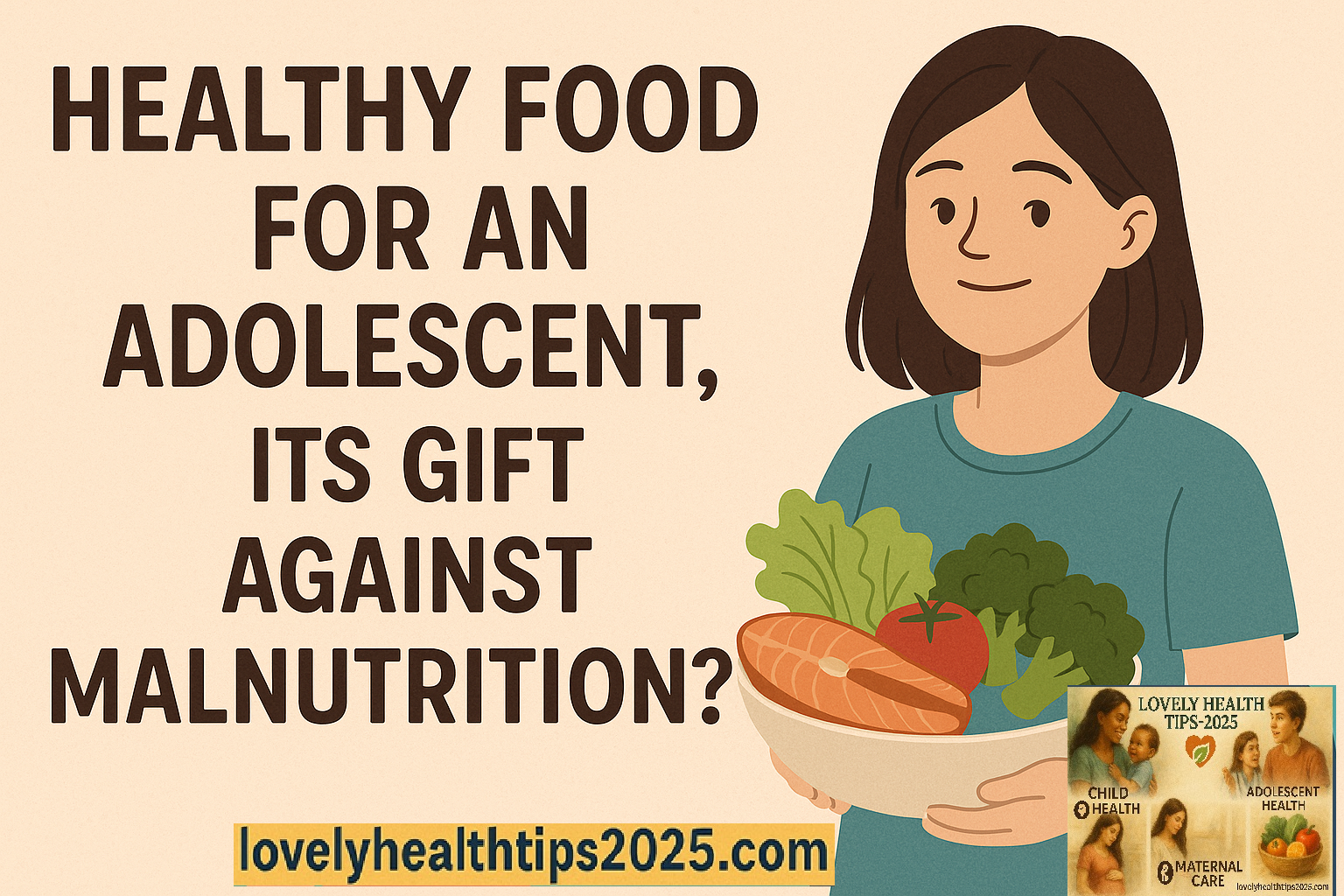Last Updated on November 16, 2025 by Lovely Health Tips-2025
Healthy Food
Malnutrition and nutrition : Healthy Food
Fight against Malnutrition : Body functions require food as an essential operating factor in the same way that machines function with fuel. Consuming this vital nutrient offers our body power and helps develop muscles along with body frameworks and keeps us healthy.
- Nutrition is the process by which the body provides for the nutrition.
- You could also see this process referred to as ingestion, digestion, absorption and assimilation of food.
- Food is the one them and helps us do our daily work.
- The process of development and health state strongly depends on proper nutrition. If anyone is having better nutrition i.e. which is equal to his/her longer life, may have strong immune systems, probalility of safe pregnancy and delivery process, lowering the rates of various non-communicable disease viz. diabetes & heart disease and also healthier mothers, babies & children.
Malnutrition :
Malnutrition means imbalance, excess or deficiency of nutrients in the body. Poor nutrition makes children, adolescents, pregnant women and nursing mothers more susceptible to illness and even death. an imbalance, excess or deficiency of nutrients in the diet. We have to fight against malnutrition and consume Healthy Food.
Addresses three groups :
- Under-nutrition
- Micro-nutrients causing malnutrition
- Overweight, obesity and diet-related
A. Under nutrition:
- Also referred to as wasting, when a person’s weight falls below normal for their height, it may be a result of not having enough to eat or from an infection, especially when the malnutrition has led to weight loss
- The term stunting refers to low height for feed. It is caused by recurring or lasting malnutrition, usually due to economic difficulties, unhealthy eating and medical care for mothers, common illness in children and inappropriate infant or young child feeding. The brain and body functions of people stop achieving their maximum capacity because of growth restrictions.
- The underweight child or adolescent is the one who has weight lower than the required one according to the age. An individual who is underweight may be wasted, stunted, or both.
B. Micro-nutrient malnutrition:
Having a vitamin or mineral deficiency: If the body cannot benefit from a sufficient amount of nutrients in the foods it eats, it is considered a nutritional deficiency. Lack of some nutrients can lead to different health complications.
C. Overweight, obesity and health problems connected to food are rising:
- Overweight that could be harmful to one’s health
- The relationship between the amount of consumed energy and the amount expended energy affects overall health negatively.
Nutritional Basics Represent the Most Effective Tools to Address Malnutrition :
- Carbohydrate:
- Energy-producing
- Vitamins and minerals
- Good health promotion combined with illness prevention benefits populations
- Contribute to several functioning parts of your body
- Proteins
- Mostly for development
- Bodybuilding
- Fats :
- Give the body energy
- It encourages for the purpose of formation of cells
- Water:
- Water boosts mood levels and improves brain operations.
- It gives the body water, gives each cell vital nutrients, stops constipation and helps remove impurities.
Deficiencies of micronutrients continue to be major nutritional causes :
- Micronutrient deficiencies serve as a fundamental disease risk factor responsible for world health conditions. Iron deficiency and iron deficiency anemia account for several DALYs (more than 2,500 / 100,000 adolescents) per population.
- Adolescent girls experience a greater risk of iron deficiency and iron deficiency anemia as compared to their male peers anywhere between 14 and 19 of age and most notably in countries that demonstrate low Social Development Indexes (SDI).
- Key takeaways in terms of micro-nutrient deficiencies are due to insufficient iodine, and is more widespread among female adolescence.
Underweight :
Less than two Standard Deviations (SDs) from the median BMI by age and sex is known as underweight (thinness), and it affects 8.4% of girls and 12.4% of boys.
Overweight :
Among teenagers in Low and Low Middle Income Countries (LMICs), over-nutrition is becoming a more significant population health concern.
Many recommendations for Daily Allowance of Nutrients for Adolescents :

Need of Nutrition in Adolescent period:
- Adolescence has greater nutritional needs because of the growth spurt.
- Additional iron needs for teenage girls
- Wellness through proper nutrition enables teenagers to perform tasks of studying, playing sports and normal physical and mental development.
Fast Food:
The calorie value of frequently eaten foods amounts to 100 grams
- Pizza has 295 calories.
- Burger: 266 calories
- 536 calories in chips
- With 262 calories, a samosa
- 38 calories from soft drinks
- 546 calories from chocolate
- 300 calories from jalebi
- Cake has 256 calories.

2. Reasons why teens are more prone to choose bad foods ?
They might pick less healthy foods or pressures from being thin thanks to what their friends and the media show them.
- Not all youth would like to eat out with their parents.
- Whatever changes people’s schedules, fast food stands are on hand to meet their needs.
- People may skip meals or even consume the fast food instead of preparing their food everyday.
- It is very difficult to find nutritious foods in school cafeterias.
- Having trouble choosing meals for working or married adolescents, particularly girls who might be the last in the family to eat
- At this stage, adolescents start making their own decisions about food which also changes their diet Pizza, burgers, bread pakoras, samosas and soft beverages are the most typical food items bought by teenagers at fast food joints.
- They contain many calories and not many healthy nutrients and they might make it less likely for you to eat a healthy meal.
- People care more about availability, when it can be purchased and how convenient it is than about the value of healthy food.
Adolescents Are More Probably to Choose Un- healthy Food : Care for undernourished people.
- Media proportionate and friendly actions motivate young people to reach specific body shapes.
- Dining in a family setting has limited potential to be optimal. Family home cooking preceded by family meals is frequently not an optimal decision. This may not be ideal, cooking at home and eating with the family members.
- Simple access to fast food.
- Not eating or substituting fast food for meals.
- Several locations offer restricted choices of nutritious food.
Factors which affecting nutrition of adolescents:
a. Factors Due to health and conditioning
- Diseases that are infectious
- Intestinal parasites, diarrhea, malaria and tuberculosis can be the reasons for malnutrition.
- Infection can happen many times if the environment is not properly cleaned
b. Many types of food preferences & also different cultural considerations
- Cultural practices
- Dietary habits, customs, beliefs, traditions, and attitudes are transmitted by Family members.
- Communication and beliefs of different groups of people strongly affect their routine food consumption.
- Personal preference as well as food dislike influences diet choices which result in repeated poor food selections that potentially lead to nutritional deficiencies.
- Cooking method plays an important role in healthiness of food, for example deep fried food have less nutritional value
c. Socio-economic factors :
Large family sizes, poverty, ignorance of the nutritional worth of foods, and ignorance about locally accessible and reasonably priced foods, among other factors.
d. Gender issues :
- In most families girls and women have to wait till last and eat the remain food. Menstruating girls are also under a nutritional deficit
- Some young women marry young, become pregnant, and give birth early, all of which worsen their nutritional state.

Factors affecting adolescents nutrition:
- Conditioning factors :
- Infectious diseases
- Environmental sanitation
- Hindrances To Healthy Eating:
- Cultural practices
- Media influenced food choices
- Cooking practices
- Socio-economic factors
- Poverty
- Lack of knowledge
- Gender issues
- Discrimination against girls
- Early marriage and pregnancy
FAQs :
Q1. Why healthy eating is important during adolescent period?
Ans. The adolescent period spanning from 10 to 19 years is marked by speedy growth in the body. Proper body development occurs through healthy eating along with stronger immunity and prevention of malnutrition as well as enhanced brain function.
Q2. The main nutrients which should be priority considerations for adolescents are which ones?
Ans. As below:
- Proteins (for growth)
- Iron (to prevent anemia)
- Vit-D and calcium to strengthen the bone health of human
- Vit-A, Vit-C & Vit-E which are used for immunity & skin
- Zinc (for healing and growth)
Q3. Teens should choose which foods promote their health the best.
Ans. As below:
- Fresh fruits and vegetables
- Whole Grains (oats, brown rice and whole wheat).
- Lean proteins (chicken, fish and legumes)
- Milk products (Yoghurts, milk products, cheese)
- Nuts and seed
Q4. Poor eating choices made by teenagers result in malnutrition affecting the body.
Ans. Undernutrition together with anemia as well as growth constraints and weakened immunity appear due to students who skip their meals and consume junk food while failing to get essential nutrients.
Q5. Does fast food to be accepted with a nutritious meal plan?
Ans. Dietary Exceptions exist but eating these foods instead of balanced meals is not suitable. People should prepare balanced versions of their preferred snacks at home as a more beneficial option to fast food.
Q6. How do you recognize the signs of malnutrition in teen-age people?
Ans. As below
- Weight-loss or may be weight-gain
- Fatigue/weakness
- Frequent infections
- Poor concentration
- Unless you treat it properly, your hair or skin could easily tangle, tear or become dried out.
Q7. How do parents influence teenagers to live healthier lives by encouraging them to eat healthier food?
Ans. Serving meals that include many different healthy foods helps in leadership. (Healthy Food)
- Weekly family food planning sessions & family cooking tasks to be conducted by parents and they must include their teen children Parents should include their teens.
- Serve your children healthy foods that they will like.
- Parents need to tell their teens how to read food labels and show them which foods are healthier.
Q8. Does the daily consumption of food during morning hours matter for teenagers?
Ans. Adolescents who fuel their bodies with healthy meals first thing in the morning do better in school and maintain a healthy body weight.
Q9. What is the correct amount of daily water consumption for young people to follow?
Ans. A young person should drink 6–8 water glasses (1.5–2 liters) daily, but their need will be higher after exercise.
Q10. Does adolescence malnutrition have any effect on adult health outcomes?
Ans. When a child eats poorly, they may suffer from weak bones, ongoing diseases, having limited physical activity and less effective thinking.
A small video from youtube on this topic is as mentioned below: https://www.yo utube.com/embed/tG4b3eU1Nzc?si=gd-591rczQK5JLor
Guideline of WHO for Dengue Disease and its link as mentioned below: https://www.who.int/news-room/fact-sheets/detail/healthy-diet
Thanks and Regards
About the Author – “Mr. Bibhu Ranjan Mund”, Master in Public Health (MPH) from IIHMR University, Jaipur (Rajasthan) has experience of 18 years in Public Health activities. Through “Lovely Health Tips-2025”, we share the evidence & experienced based health & wellness guides with solutions for every day well-being. More from Author
Disclaimer
This information is suggestive only and not a replacement for medical advice. For more detail, please visit to my website as mentioned below:


